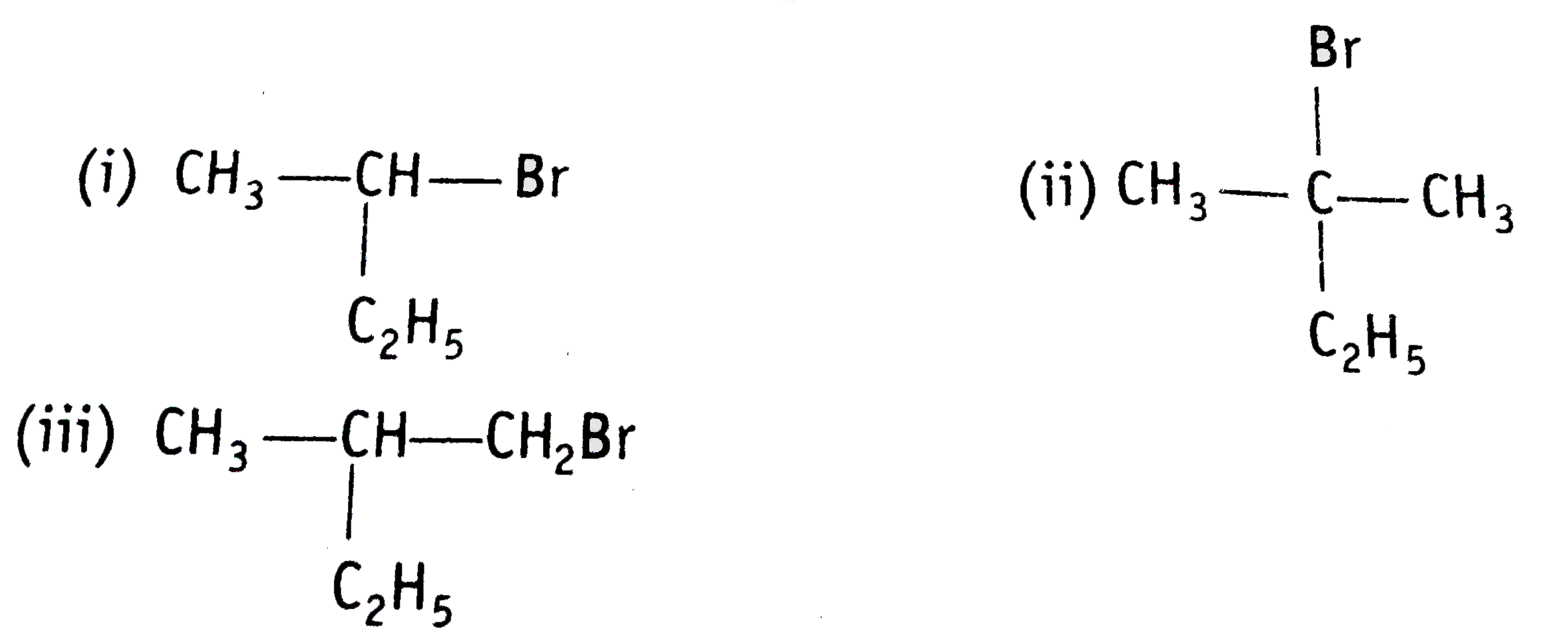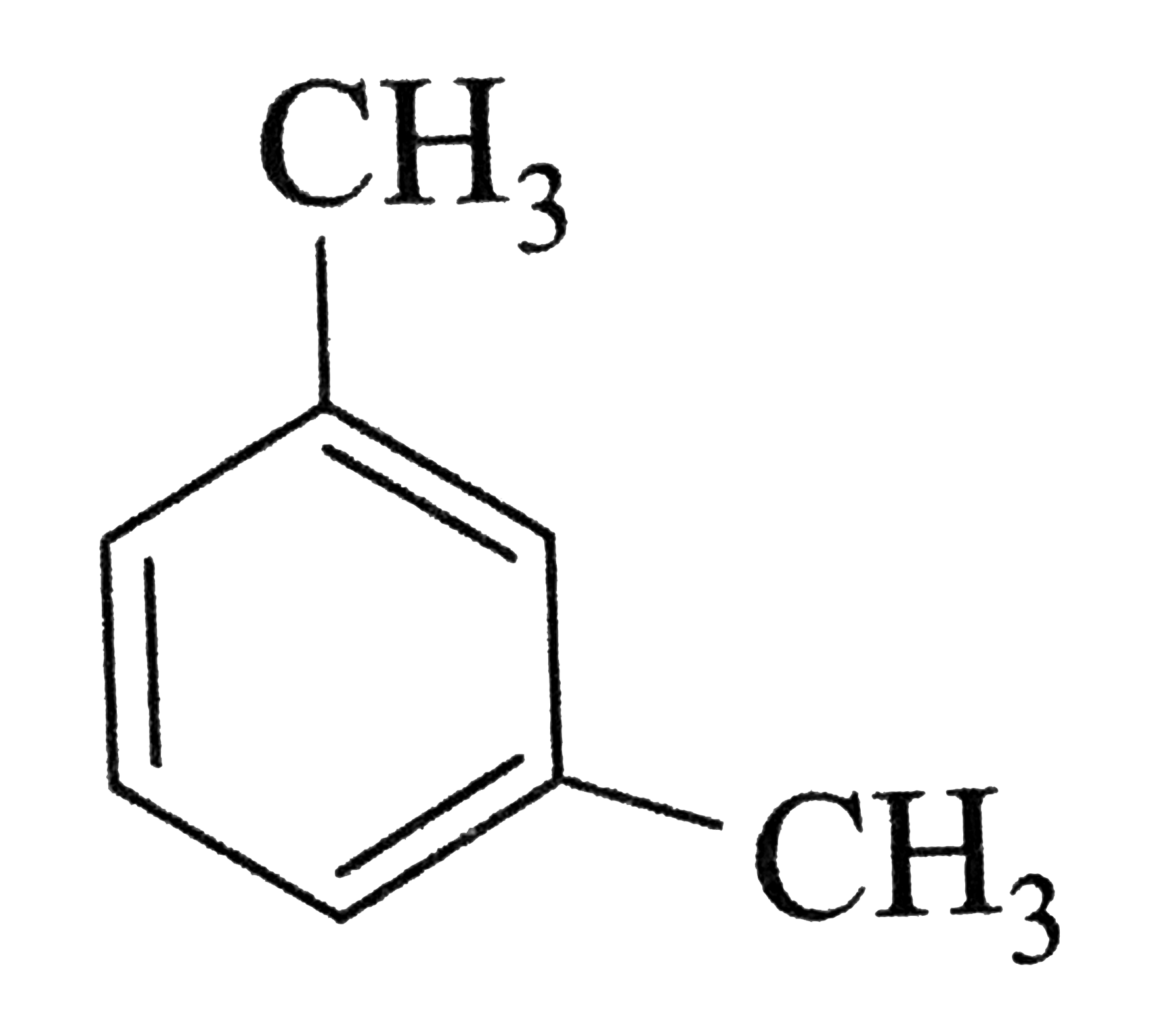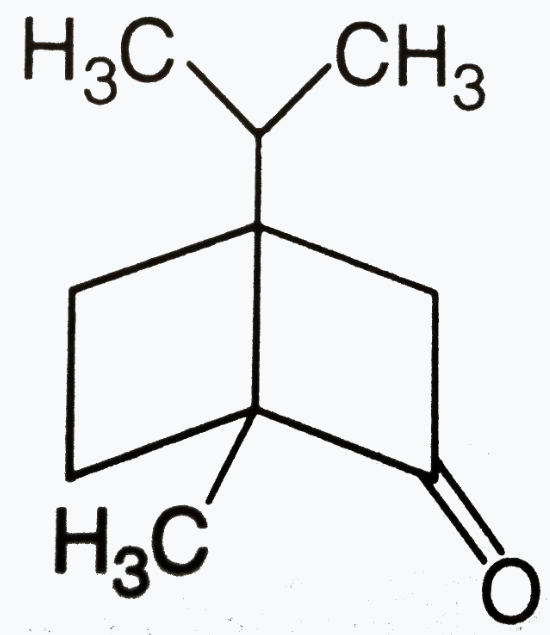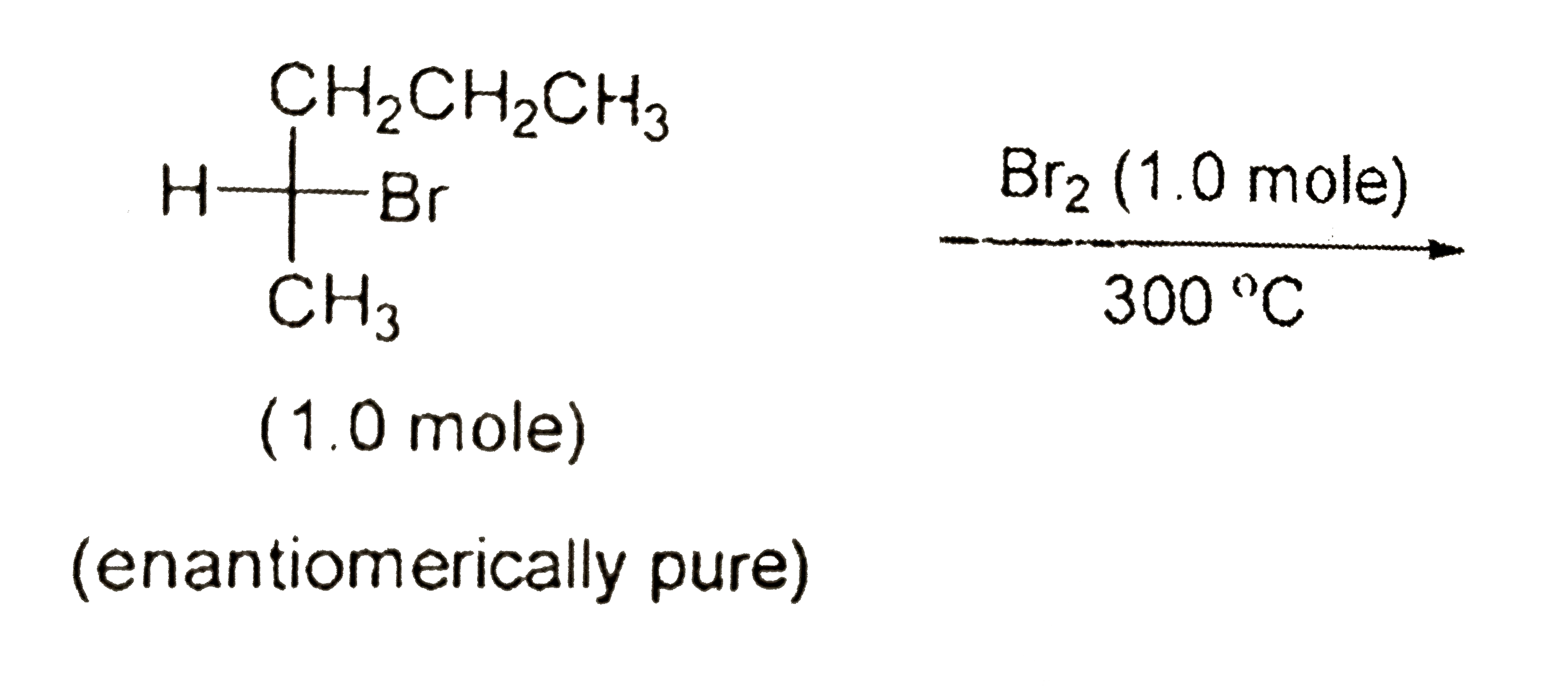Assignment from S DINESH & CO CHEMISTRY (HINGLISH) HALOALKANES AND HALOARENES for Class 12
| Class 12 | CHEMISTRY |
| Chapter | HALOALKANES AND HALOARENES |
| S DINESH & CO CHEMISTRY (HINGLISH) | Assignment |
| Medium | English |
| Academic Year | 2023-2024 |
Question 69
A sweety smelling organic compound 'A' is slowly oxidised by air in the presence of light to a highly poisonous gas. On warming with silver powder, it forms a gaseous substance 'B' whish is also formed by the action of calcium carbide on water. Identify 'A' and 'B'. writ ethe chemical equations involved.View SolutionQuestion 185
Aryl halides do not undergo nucleophilic substitution reactions under ordinary conditions because:
(1). Approach of nucleophile is retarded
(2). Carbon carrying halogen atom is sp3 hybridised.
(3). The substrate molecule is destabilised due to resonance
(4). of partial double bond character between carbon and halogen. View SolutionQuestion 216
Alkyl halides can participate in both SN1andSN2 reactions depending upon their anture and conditions. The reactivity order in the three types of alkyl halides is the reverse in SN1 reactions than what we observe in SN2 reactions. Apart from that, there is inversion of configuration in case of alkyl halides when they participate in SN2 reactions. on the other hand, partial or complete racemisation occurs in SN1 reactions.
Q. SN1 reactions take place much more rapidly in polar solvents than in non-polar solvents. this is because of hydration of nucleophile.View SolutionQuestion 217
Alkyl halides can participate in both SN1andSN2 reactions depending upon their anture and conditions. The reactivity order in the three types of alkyl halides is the reverse in SN1 reactions than what we observe in SN2 reactions. Apart from that, there is inversion of configuration in case of alkyl halides when they participate in SN2 reactions. on the other hand, partial or complete racemisation occurs in SN1 reactions.
Q. An optically active halide when allowed to react with CN−, gives a racemic mixture. the halide is most likely to be: primaryView SolutionQuestion 218
In both alkyl halides and aryl halides, the halogen (X) atom is attached directly to the carbon atom. They are expected to exhibit similar reactivity. However, aryl halides are comparatively very little reactive, particularly towards nucleophilic substitution reaction. for example, hydrolysis of ethyl chloride occurs by simply boiling with aqueous KOH. ON the other hand, the alkaline hydrolysis of chlorobenzene requires a very high temperature (623K) as well as a very high pressure.
Q. Among the following which has weakest C-X bond?View SolutionQuestion 219
In both alkyl halides and aryl halides, the halogen (X) atom is attached directly to the carbon atom. They are expected to exhibit similar reactivity. However, aryl halides are comparatively very little reactive, particularly towards nucleophilic substitution reaction. for example, hydrolysis of ethyl chloride occurs by simply boiling with aqueous KOH. ON the other hand, the alkaline hydrolysis of chlorobenzene requires a very high temperature (623K) as well as a very high pressure.
Q. The halide which does not give any precipitate when warmed with alcoholic AgNO3 solution is:View SolutionQuestion 220
In both alkyl halides and aryl halides, the halogen (X) atom is attached directly to the carbon atom. They are expected to exhibit similar reactivity. However, aryl halides are comparatively very little reactive, particularly towards nucleophilic substitution reaction. for example, hydrolysis of ethyl chloride occurs by simply boiling with aqueous KOH. ON the other hand, the alkaline hydrolysis of chlorobenzene requires a very high temperature (623K) as well as a very high pressure.
Q. Benzene reacts with Cl2 in the presence of FeCl3 (and absence of sun light) to form:View SolutionQuestion 221
In both alkyl halides and aryl halides, the halogen (X) atom is attached directly to the carbon atom. They are expected to exhibit similar reactivity. However, aryl halides are comparatively very little reactive, particularly towards nucleophilic substitution reaction. for example, hydrolysis of ethyl chloride occurs by simply boiling with aqueous KOH. ON the other hand, the alkaline hydrolysis of chlorobenzene requires a very high temperature (623K) as well as a very high pressure.
Q. Friedel Craft's reaction of bromobenzene with methyl iodide gives,View SolutionQuestion 222
The high reactivity of alkyl halides can be explained in terms of nature of C−X bond which is a highly polarised covalent bond. This polarity is responsible for the nucleophilic substitution reaction of alkyl halides which jmostly occur by SN1andSN2 mechanisms. SN1 reaction is a two step process and in the first step R−X ionises to give carbocation (slow process). IN the second step, the nucleophile attacks the carbocation from either side to form the product (fast process). IN SN1 reaction, there can be racemization and inversion. SN1 reaction is favoured by heavy (bulky) group on the carbon atom attached to halogens. IN SN2 reaction, the strong nucleophile OH− attacks fromt he opposite side
Of the halogen atom to give an intermediate (transition state), which breaks to yields to product (alcohol) and leaving group (X−). The alcohol has a configuratio opposite to that of the halide and is said to proceed with inversion of configuration. SN2 reaction is favoured by small groups on the carbon atom attached to halogen.
Q. Which among the following will not give SN1 reaction?View SolutionQuestion 223
The high reactivity of alkyl halides can be explained in terms of nature of C−X bond which is a highly polarised covalent bond. This polarity is responsible for the nucleophilic substitution reaction of alkyl halides which jmostly occur by SN1andSN2 mechanisms. SN1 reaction is a two step process and in the first step R−X ionises to give carbocation (slow process). IN the second step, the nucleophile attacks the carbocation from either side to form the product (fast process). IN SN1 reaction, there can be racemization and inversion. SN1 reaction is favoured by heavy (bulky) group on the carbon atom attached to halogens. IN SN2 reaction, the strong nucleophile OH− attacks fromt he opposite side
Of the halogen atom to give an intermediate (transition state), which breaks to yields to product (alcohol) and leaving group (X−). The alcohol has a configuratio opposite to that of the halide and is said to proceed with inversion of configuration. SN2 reaction is favoured by small groups on the carbon atom attached to halogen.
Q. Which one of the following compounds is most readily hydrolysed by SN1 mechanism.?View SolutionQuestion 224
The high reactivity of alkyl halides can be explained in terms of nature of C−X bond which is a highly polarised covalent bond. This polarity is responsible for the nucleophilic substitution reaction of alkyl halides which jmostly occur by SN1andSN2 mechanisms. SN1 reaction is a two step process and in the first step R−X ionises to give carbocation (slow process). IN the second step, the nucleophile attacks the carbocation from either side to form the product (fast process). IN SN1 reaction, there can be racemization and inversion. SN1 reaction is favoured by heavy (bulky) group on the carbon atom attached to halogens. IN SN2 reaction, the strong nucleophile OH− attacks fromt he opposite side
Of the halogen atom to give an intermediate (transition state), which breaks to yields to product (alcohol) and leaving group (X−). The alcohol has a configuratio opposite to that of the halide and is said to proceed with inversion of configuration. SN2 reaction is favoured by small groups on the carbon atom attached to halogen.
Q. The main product formed in the following reaction is :
CH3−C∣CH3H−CH2Br+CH3CH2O−SN1→View SolutionQuestion 225
The high reactivity of alkyl halides can be explained in terms of nature of C−X bond which is a highly polarised covalent bond. This polarity is responsible for the nucleophilic substitution reaction of alkyl halides which jmostly occur by SN1andSN2 mechanisms. SN1 reaction is a two step process and in the first step R−X ionises to give carbocation (slow process). IN the second step, the nucleophile attacks the carbocation from either side to form the product (fast process). IN SN1 reaction, there can be racemization and inversion. SN1 reaction is favoured by heavy (bulky) group on the carbon atom attached to halogens. IN SN2 reaction, the strong nucleophile OH− attacks fromt he opposite side
Of the halogen atom to give an intermediate (transition state), which breaks to yields to product (alcohol) and leaving group (X−). The alcohol has a configuratio opposite to that of the halide and is said to proceed with inversion of configuration. SN2 reaction is favoured by small groups on the carbon atom attached to halogen.
Q. Which of the following is an example of SN2 reaction?View SolutionQuestion 293
Which of the following phreases are not correvlty associated with SN1 reaction ?
(I) Rearrangement is possible
(II) Rate si affected by polarity of solvent
(III) the strength of the nuclephile is important in determining rate
(IV) the reacityity series is tertiary gt secondary gt promany
(V) proceeds with complete inversion of configguation View Solution
All Exercises from S DINESH & CO CHEMISTRY (HINGLISH) Class 12 CHEMISTRY HALOALKANES AND HALOARENES
- ASSERTION-REASON TYPE
- ASSIGNMENT
- BRAIN STORMING MULTIPLE CHOICE QUESTIONS
- COMPREHENSION
- HALOARENES
- INTEGER
- JEE MAIN & OTHER ENGINNERING ENTRANCE EXAMINATION
- MATRIX
- MULTIPLE CHOICE
- SINGLE CORRECT OPTION
- STRAIGHT OBJECTIVE TYPE
- ASSERTION-REASON TYPE
- ASSIGNMENT
- BRAIN STORMING MULTIPLE CHOICE QUESTIONS
- COMPREHENSION
- HALOARENES
- INTEGER
- JEE MAIN & OTHER ENGINNERING ENTRANCE EXAMINATION
- MATRIX
- MULTIPLE CHOICE
- SINGLE CORRECT OPTION
- STRAIGHT OBJECTIVE TYPE
- QUESTION BANK
- ASSERTION-REASON TYPE
- ASSIGNMENT
- BRAIN STORMING MULTIPLE CHOICE QUESTIONS
- COMPREHENSION
- HALOARENES
- INTEGER
- JEE MAIN & OTHER ENGINNERING ENTRANCE EXAMINATION
- MATRIX
- MULTIPLE CHOICE
- SINGLE CORRECT OPTION
- STRAIGHT OBJECTIVE TYPE
- ASSERTION-REASON TYPE
- ASSIGNMENT
- BRAIN STORMING MULTIPLE CHOICE QUESTIONS
- COMPREHENSION
- HALOARENES
- INTEGER
- JEE MAIN & OTHER ENGINNERING ENTRANCE EXAMINATION
- MATRIX
- MULTIPLE CHOICE
- SINGLE CORRECT OPTION
- STRAIGHT OBJECTIVE TYPE
- QUESTION BANK
- ASSERTION-REASON TYPE
- ASSIGNMENT
- BRAIN STORMING MULTIPLE CHOICE QUESTIONS
- COMPREHENSION
- HALOARENES
- INTEGER
- JEE MAIN & OTHER ENGINNERING ENTRANCE EXAMINATION
- MATRIX
- MULTIPLE CHOICE
- SINGLE CORRECT OPTION
- STRAIGHT OBJECTIVE TYPE
- ASSERTION-REASON TYPE
- ASSIGNMENT
- BRAIN STORMING MULTIPLE CHOICE QUESTIONS
- COMPREHENSION
- HALOARENES
- INTEGER
- JEE MAIN & OTHER ENGINNERING ENTRANCE EXAMINATION
- MATRIX
- MULTIPLE CHOICE
- SINGLE CORRECT OPTION
- STRAIGHT OBJECTIVE TYPE
- QUESTION BANK
- ADDITIONAL IMPORTANT QUESTIONS
- EXAMPLE
- HIGHER ORDER THINKING SKILLS QUESTIONS
- LONG ANSWER TYPE QUESTION
- NCERT
- PROBLEM FOR PRACTICE
- QUESTION FROM BOARD EXAMINATIONS
- SHORT ANSWER TYPE QUESTIONS
- SOME TYPICAL WORK PROBLEMS BASED ON COVERSIONS
- ADDITIONAL IMPORTANT QUESTIONS
- EXAMPLE
- HIGHER ORDER THINKING SKILLS QUESTIONS
- LONG ANSWER TYPE QUESTION
- NCERT
- PROBLEM FOR PRACTICE
- QUESTION FROM BOARD EXAMINATIONS
- SHORT ANSWER TYPE QUESTIONS
- SOME TYPICAL WORK PROBLEMS BASED ON COVERSIONS
- ADDITIONAL IMPORTANT QUESTIONS
- EXAMPLE
- HIGHER ORDER THINKING SKILLS QUESTIONS
- LONG ANSWER TYPE QUESTION
- NCERT
- PROBLEM FOR PRACTICE
- QUESTION FROM BOARD EXAMINATIONS
- SHORT ANSWER TYPE QUESTIONS
- SOME TYPICAL WORK PROBLEMS BASED ON COVERSIONS
- ADDITIONAL IMPORTANT QUESTIONS
- EXAMPLE
- HIGHER ORDER THINKING SKILLS QUESTIONS
- LONG ANSWER TYPE QUESTION
- NCERT
- PROBLEM FOR PRACTICE
- QUESTION FROM BOARD EXAMINATIONS
- SHORT ANSWER TYPE QUESTIONS
- SOME TYPICAL WORK PROBLEMS BASED ON COVERSIONS
- ADDITIONAL IMPORTANT QUESTIONS
- EXAMPLE
- HIGHER ORDER THINKING SKILLS QUESTIONS
- LONG ANSWER TYPE QUESTION
- NCERT
- PROBLEM FOR PRACTICE
- QUESTION FROM BOARD EXAMINATIONS
- SHORT ANSWER TYPE QUESTIONS
- SOME TYPICAL WORK PROBLEMS BASED ON COVERSIONS
- ADDITIONAL IMPORTANT QUESTIONS
- EXAMPLE
- HIGHER ORDER THINKING SKILLS QUESTIONS
- LONG ANSWER TYPE QUESTION
- NCERT
- PROBLEM FOR PRACTICE
- QUESTION FROM BOARD EXAMINATIONS
- SHORT ANSWER TYPE QUESTIONS
- SOME TYPICAL WORK PROBLEMS BASED ON COVERSIONS


 .
.



 ltBrgt What is 'A' in the following reaction?
ltBrgt What is 'A' in the following reaction?






 .
.


 .
.
 .
. .
.
 .
.
 .
. 
 .
.
 .
. .
.



 .
. 
 .
.  .
.

 .
. .
.

 .
.


 .
. .
.


 .
. .
.

 .
.



 .
.
 .
.  .
.
 .
. .
. Match each reaction in List-I with one or more products in ListII and choose the correct option.
Match each reaction in List-I with one or more products in ListII and choose the correct option.


